Bài đăng trên blog này đề cập đến sự khác biệt giữa POC, MVP và Prototype để xác thực các giả định với bộ tính năng tối thiểu cho người dùng ban đầu. Chúng ta sẽ xem xét chi tiết từng cách tiếp cận, so sánh chúng và thảo luận về cách chọn chiến lược phù hợp nhất với thị trường sản phẩm phù hợp để phát triển ứng dụng của bạn.
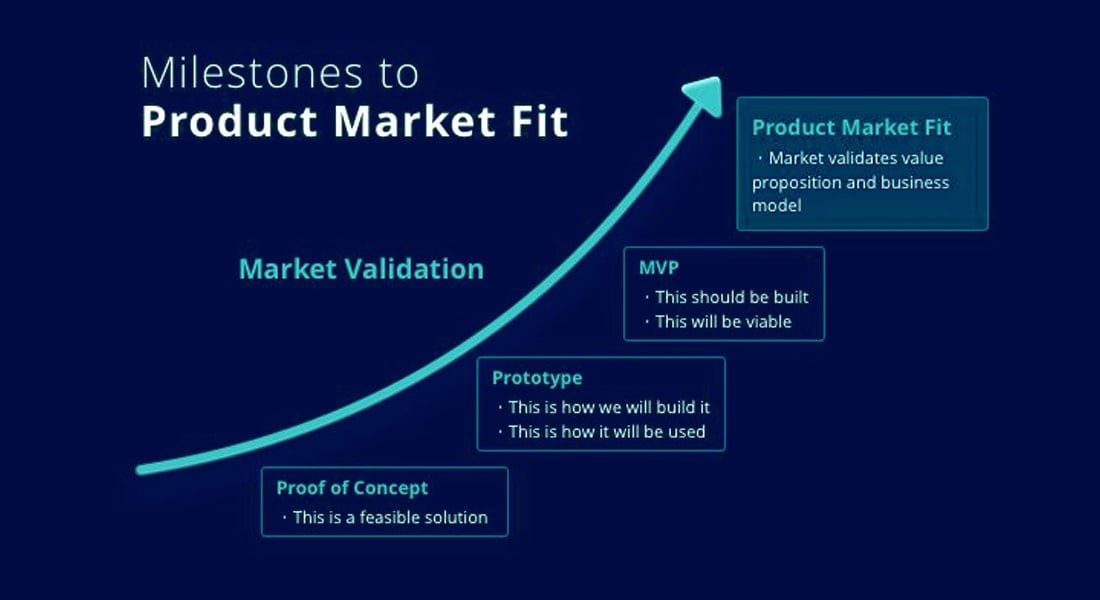
Nội dung
- Giới thiệu
- Tổng quan về MVP, Prototype và POC
- POC vs Prototype vs MVP: Sự khác biệt là gì?
- Những cân nhắc chính trước khi phát triển theo MVP, Prototype, hoặc POC
- POC vs Prototype vs MVP: Làm thế nào để chọn cách tiếp cận tốt nhất?
- Từ POC đến Prototype đến MVP: Là một nhưng không giống nhau
- Kết luận
Giới thiệu
Mọi doanh nghiệp đều phải đối mặt với nhiều thách thức khi lựa chọn MVP, POC và Prototype trong giai đoạn đầu phát triển sản phẩm của mình. Đôi khi nó cũng có thể dẫn đến sự lựa chọn sai lầm về chiến lược. Bằng những kết quả của giai đoạn này, tổ chức của bạn có thể xem xét về vấn đề tài chính và ngừng tăng trưởng tổng thể doanh nghiệp. Tùy thuộc vào lộ trình dự án, các phương pháp MVP và Prototype có thể được sử dụng cùng nhau hoặc độc lập.
Một số tổ chức trong Fortune 500 cũng đã thất bại trong việc thu hút khách hàng khi giới thiệu một ứng dụng mới trên thị trường ở giai đoạn đầu. Khi nói đến việc phát triển một sản phẩm mới, chúng ta cần đảm bảo rằng các vấn đề thực tế của người dùng cuối đang được giải quyết bằng giải pháp phù hợp với thị trường sản phẩm.
Chúng ta hãy đi sâu vào các khái niệm về POC, Prototype và MVP, một cách tiếp cận lý tưởng để khởi nghiệp.
Tổng quan về MVP, Prototype và POC
POC
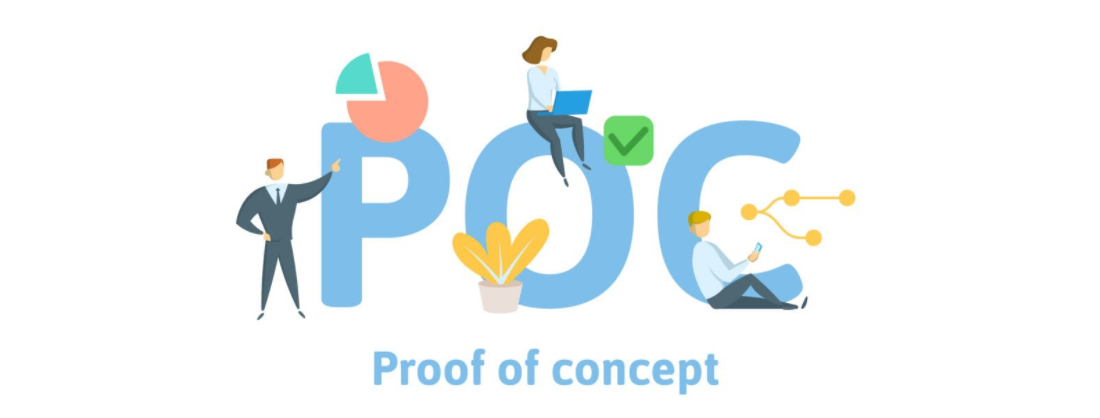
Proof of Concept là một dự án nhỏ được sử dụng để xác minh các khái niệm kỹ thuật như công nghệ, phương pháp và tích hợp. POC được sử dụng trước khi tung sản phẩm ra thị trường và trước khi bắt đầu phát triển sản phẩm của mình.
Mục tiêu là đánh giá tính khả thi của ý tưởng và xác nhận các giả định được đưa vào bức tranh tổng thể. Proof of Concept không được cung cấp công khai cho mọi khách hàng, khiến nó không thể sử dụng được vì nó chỉ có phạm vi xác minh xem ý tưởng có khả thi trong hoạt động hay không.
Nếu công ty khởi nghiệp của bạn đang đổi mới thì khả năng triển khai thực tế của ý tưởng mới là không chắc chắn. Tùy thuộc vào nghiên cứu ban đầu, việc phát triển ứng dụng POC cho phép bạn đánh giá xem sản phẩm của bạn có chạy hoàn hảo về mặt kỹ thuật hay không. Nếu nó không hoạt động, nó có thể bị hủy bỏ hoặc thay đổi ban đầu. Không bắt buộc phải phát triển POC nếu ý tưởng này đã có sẵn trên thị trường.
Chúng ta nhận được gì với phương pháp tiếp cận POC? POC là một công cụ để xác nhận một sản phẩm độc nhất. Hãy xem qua những lợi ích của việc thực hiện phương pháp POC:
- Thu hút các nhà đầu tư ban đầu: POC hoạt động tốt nhất để thu hút các khoản đầu tư và nhà đầu tư sẵn sàng tài trợ cho các ý tưởng đã được chứng minh.
- Tiết kiệm rất nhiều thời gian: Trong một khoảng thời gian ngắn, POC đảm bảo rằng bạn biết liệu dự án của mình có thể được triển khai hay không và tiến tới cấp độ phát triển khởi nghiệp tiếp theo.
- Đưa ra lựa chọn chính xác: Để giảm thiểu rủi ro lớn, bạn có thể tạo nhiều POC bằng các công nghệ khác nhau.
- Luôn dẫn trước đối thủ: POC là một cách tiếp cận ít tốn chi phí để phát triển một sản phẩm mới và độc đáo nhằm cải tiến hoạt động kinh doanh.
Proof of Concept hoạt động như thế nào?
Nếu chúng ta nghi ngờ về tính khả thi của ý tưởng, POC có tác dụng cho chúng ta biết hai khả năng là có hoặc không. Với kết quả tích cực, chúng ta có thể quyết định tiếp tục xây dựng dự án của mình, trong khi kết quả không tốt sẽ cho chúng ta biết không nên tiếp tục với một dự án có khả năng không khả thi.
Là một phần của phương pháp tiếp cận nội bộ, luồng quy trình POC không nhằm mục đích hiển thị cho người dùng của chúng ta mà nhằm giải quyết các vấn đề nghiêm trọng. Bên cạnh đó, kết quả có thể dùng để quảng cáo nó cho các nhà đầu tư tiềm năng của chúng ta và có thể thu được thành quả từ việc huy động vốn ban đầu.
Success Story of Walmart POC
Công nghệ chuỗi khối được sử dụng để tạo ra tiền điện tử. Tuy nhiên, Walmart đã quyết định triển khai công nghệ này để cải thiện hệ thống hậu cần của mình bằng cách truy tìm nguồn gốc sản phẩm. Nhóm Walmart đã tạo POC để tìm hiểu xem liệu công nghệ blockchain có phù hợp với ý tưởng này hay không.
Năm 2016, họ đã tạo ra hai sản phẩm nhỏ để thử nghiệm công nghệ blockchain. Cái đầu tiên dùng để theo dõi nguồn gốc xoài ở Mỹ và cái thứ hai dùng để theo dõi thịt được bán bởi các cửa hàng Walmart ở Trung Quốc.
Hai dự án này được tạo ra nhằm đẩy nhanh quá trình xác định nguồn gốc của hàng hóa được kiểm nghiệm thành công. Nhờ công nghệ chuỗi khối. Họ đã giúp công ty theo dõi nguồn gốc sản phẩm, xem ngày gửi hàng, kiểm tra hậu cần và đến siêu thị trong vòng vài giây.
Ngày nay, Walmart đang triển khai thành công công nghệ blockchain bằng cách mở rộng chức năng của hệ thống dựa trên blockchain.
Prototype - Bản mẫu
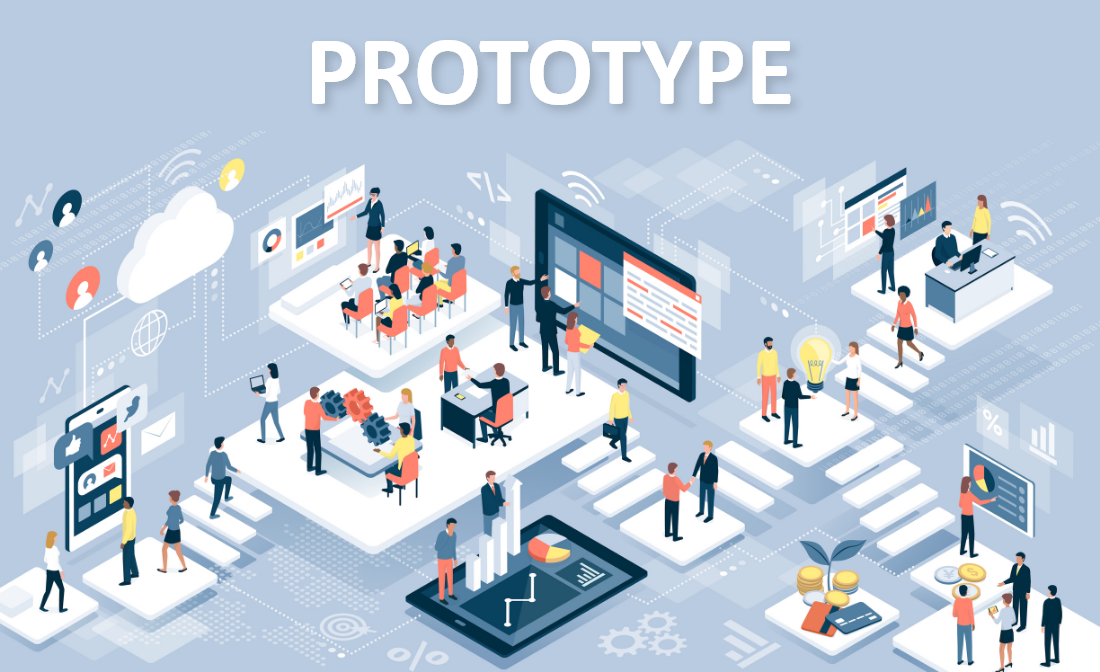
Mục tiêu: Để chứng tỏ sản phẩm sẽ trông như thế nào.
Một Prototype thể hiện các yếu tố thiết kế chính và xác định luồng người dùng. Nó tập trung vào việc xác định giao diện của sản phẩm và hiểu các quy trình công việc cơ bản của dự án cần được đưa vào trong giai đoạn phát triển sản phẩm.
Bản mẫu ứng dụng dành cho thiết bị di động là gì?
Bản mẫu ứng dụng dành cho thiết bị di động cho thấy cách ứng dụng sẽ chuyển từ màn hình này sang màn hình khác và xử lý quá trình phát triển ứng dụng. Chúng ta có thể hình dung UX trước khi bắt đầu phát triển dự án của mình.
Nhiều người nhầm lẫn giữa POC và Prototype, sự khác biệt cơ bản là ở chỗ bằng chứng trước đây chứng minh liệu một sản phẩm hoặc các tính năng của nó có thể được phát triển hay không.
In contrast, the latter demonstrates how it will be developed.
What Do You Get With the Prototype Approach?
Have a look at the benefits of implementing a Prototype for your startup:
- Design concept validation: You can run multiple tests on a design until you get the desired output.
- Resource savings: It helps you to determine potential design flaws before product development, prevent rework, and reduce unnecessary expenses.
- Immediate feedback: While testing the prototype, you get direct feedback from live people that helps you quickly identify downsides, fix them, and continue further development.
- Initial investment: A tested prototype with great looks can be shown to your investors, and you can convince them that your idea is worth investing in.
How does Prototyping Work?
How to build a product prototype? To create a simplified introductory design, the startup owner will define all system requirements. Then, the prototype will be developed & tested. Once you identify the errors and strong points, the developer evaluates the feedback.
Each prototype leads to the development of a new system. The entire development system is repeated until its final version meets the requirements and user specifications. This approach is the most widespread. Thus, the process flow is modified following the chosen prototyping type.
Original iPhone Prototype From 1983
Do you know that the fan following for iPhone began with a prototype? We saw the first iPhone in 2007, but the company had already gone through several iterations before zeroing down to this product which took the market by storm. The image below represents the prototype for a touchscreen Apple phone.
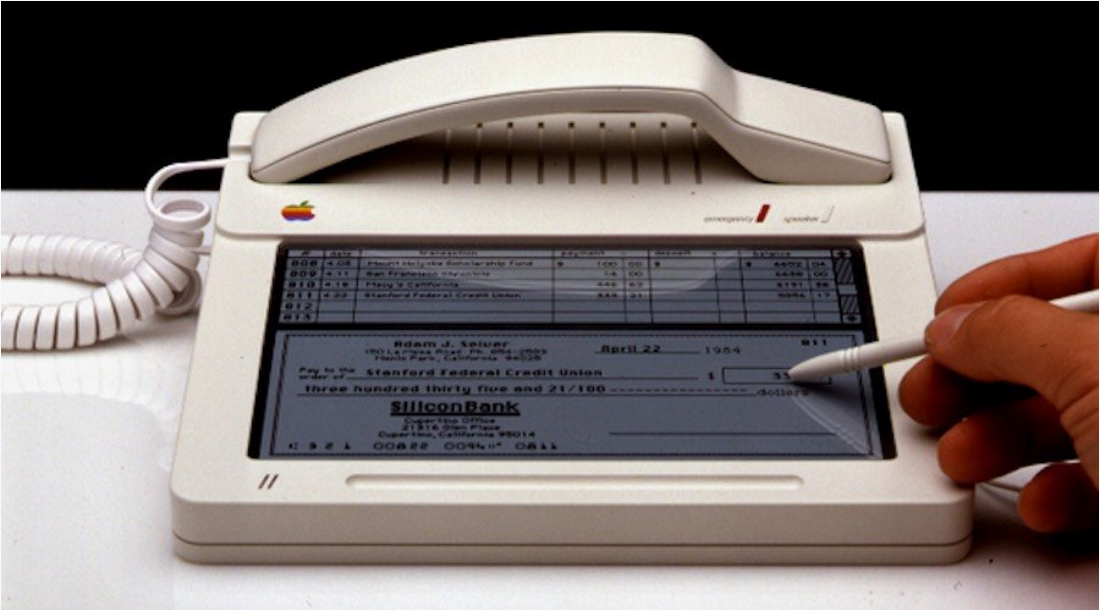
Around 1983, this prototype was designed featuring a touchscreen and stylus input and was quite slick for a device from the early 80s. It looks like the company wanted to design a touchscreen and hybrid phone as early as 1983. And after testing and improvising on this prototype, the first iPhone was launched in the market around 2007.
Minimum Viable Product (MVP)
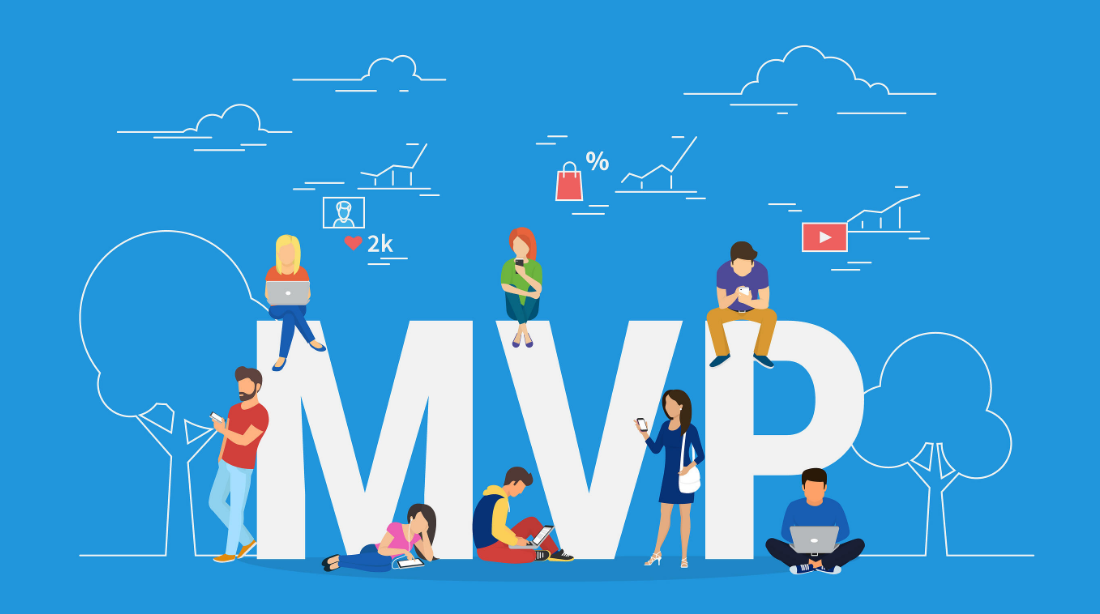
Goal: Launch and iterate based on user feedback
A Minimum Viable Product has a minimum required set of features to serve its customers and gain instant feedback for further improvement. An MVP is a functional app loaded with superior features that represent the application. It lets you know what your users like and what they anticipate in your final product.
From fundamental concept to the existence, MVP is a primary system on its own that depicts your system’s basic version providing a small set of users and comments. It is a combination of microservices that mainly focus on creating one whole thing at a time. MVP is one of the most in-demand approaches for mapping product fit.
What Do You Get With the MVP Approach?
Here are the main benefits of an MVP:
- Optimization of Expenses: MVP is a device that demands less time and money for development and enables you to plan the development path.
- A tool to attract your first user: MVP is not a thoroughly refined product, but you can originate it on the market and get your first profitable client.
- A chance to draw investors’ attention: Nobody wants to spend on ideas with unpredictable market demand. A wholly developed MVP gaining accurate user feedback is excellent assurance for investors to vest their interests.
MVP Example – Twitter
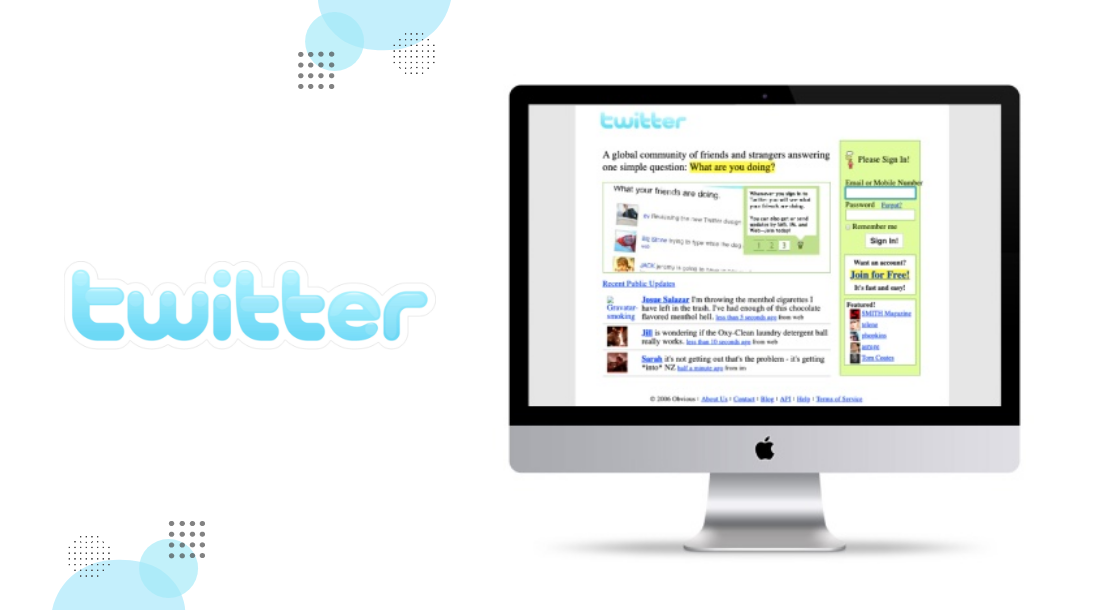
In 2001, Odeo’s podcasting business model was under threat because of the launch of Apple’s iTunes. So, they came up with an out-of-the-box idea of running hackathons to survive in the market. They conducted hackathons, which focused on generating new ideas; from the participants. It still amuses everyone to this day that Odeo’s hackathon led to the creation of the initial stage for the social media giant ‘Twitter.’
In the beginning, the employees of Odeo used this idea internally. It became trendy among employees in less time that they even started spending money posting on the platform. And ‘Twittr’ which was at its MVP stage, was scaled to one of the most loved social media platforms, “Twitter”!
POC vs Prototype vs MVP: What’s The Difference?
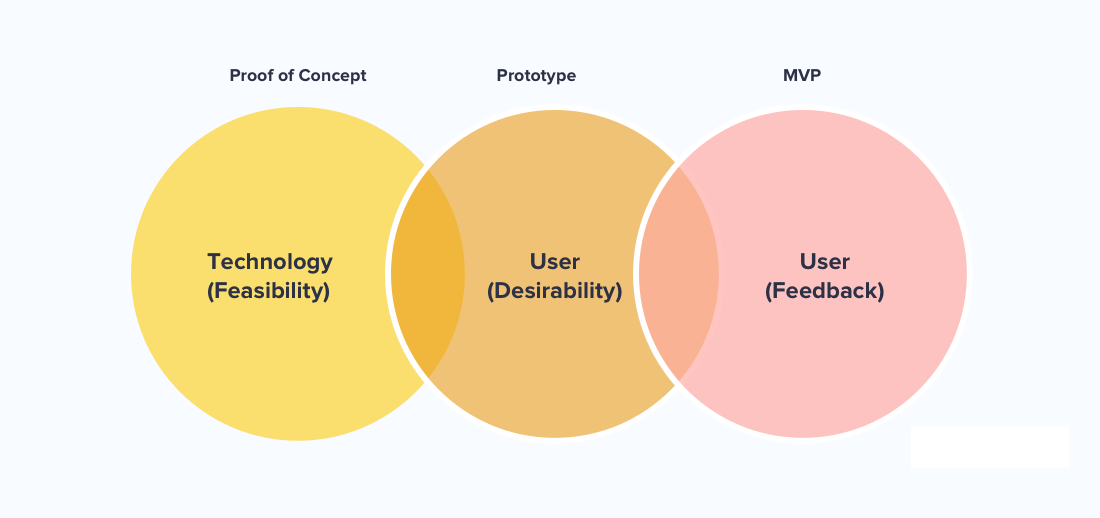
POC, MVP, and Prototype are different from each other, and so is the objective. You will easily understand the comparison of POC vs MVP vs prototype by reading in detail.
What Is the Difference between a POC and Prototype?
A proof of concept justifies the viability of bringing the idea into existence. It essentially addresses the question of feasibility that a certain idea can be realized with a specific technology.
Usually, a POC serves as an internal project, whereas a prototype can be shipped for initial feedback to learn more about the flow and design.
What Is the Difference between an MVP and Prototype?
An MVP is essentially a finished product, even if it lacks some features. With an MVP, you can collect user analytics and add or refine features in the next iterations.
A prototype lacks the business logic of your product and addresses the questions of design and UX.
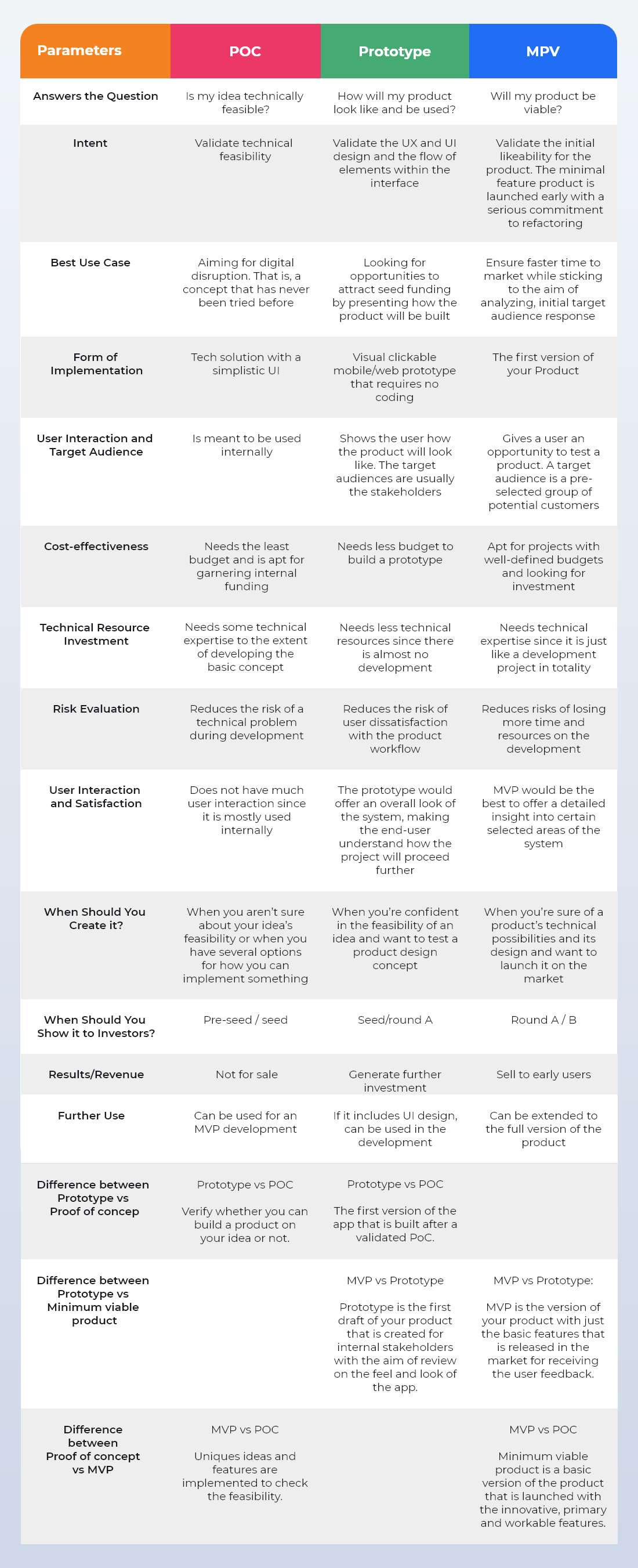
Key Considerations Before Developing an MVP, Prototype, or POC
Before choosing whether you need to develop a POC, MVP, or prototype, few inquiries need to be responded to and grasped. Once you classify the answers to these questions, you are all ready to pick from these three is undoubtedly the correct one.
- Is your idea unique?
- What do you want to verify?
- Is it required to find out if your target audience needs your product?
- Who is your target audience?
- What are your validation criteria?
- What does your business need?
- What are your measures for budget, time, and effort?
- What is your aspired output in terms of production willingness?
- Is your technology for the project discussed?
If answers to the above questions are YES, then you need to go the safe way and develop from proof of concept to prototype to MVP.
POC vs Prototype vs MVP: How to Choose the Best Approach?
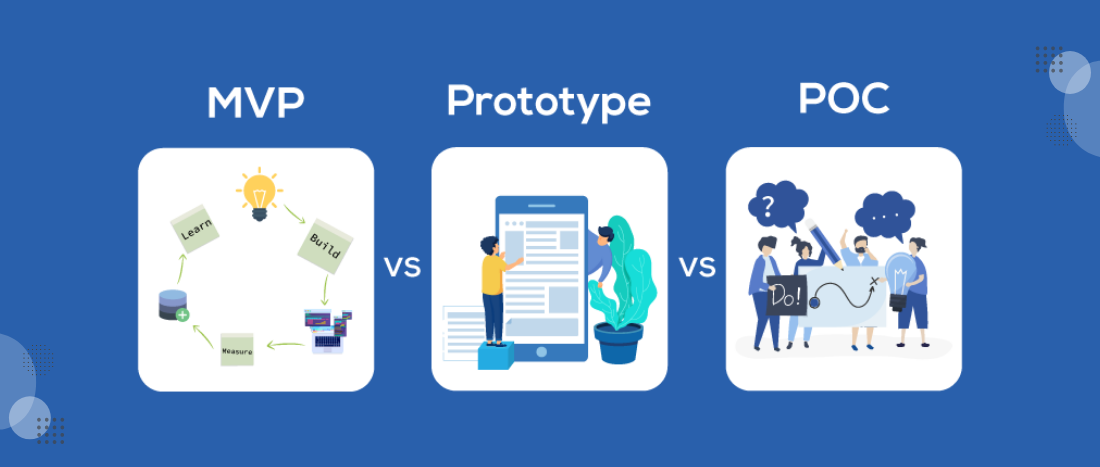
When to choose a POC?
POC is the first step while developing a fully-fledged product. You can implement this approach if the statements given below align with your current goals:
- When creating a new product with the idea that has not been tried and tested before.
- You want to confirm your idea’s feasibility before investing your time, efforts, and resources into product development.
- Make sure to verify your product’s industrial utility to secure your first investment.
- Do not implement the previously applied technology in your industry.
- When you aim to share your product and internal knowledge with the team members.
When to choose a prototype?
After creating a POC, you can move further to the prototype stage. Some clues that reveal your need to begin developing a prototype is:
- When you want to give life to your product’s look and feel to see how it will turn out at full scale.
- When you’ve limited time and money to showcase your product’s design and UX flow to attract investors.
- You aim to design a product having excellent user flow and user experience.
- When you have a quick deadline for presenting your idea to the investors.
When to choose a Minimum Viable Product (MVP)?
An MVP is not a mature product, but it is considered the last stage towards its development. You can implement this approach if:
- You want to invest minimum time and money in developing your product with the necessary features.
- You want immediate user feedback that can construct the base for further improvements.
- When you need higher retention at a lower cost.
From POC to Prototype to MVP: One But Not the Same
You can clearly interpret from this bubble chart below the representation of POC vs MVP vs Prototype. You can implement these approaches for various purposes at the stage of development. Thus, they are not interchangeable.
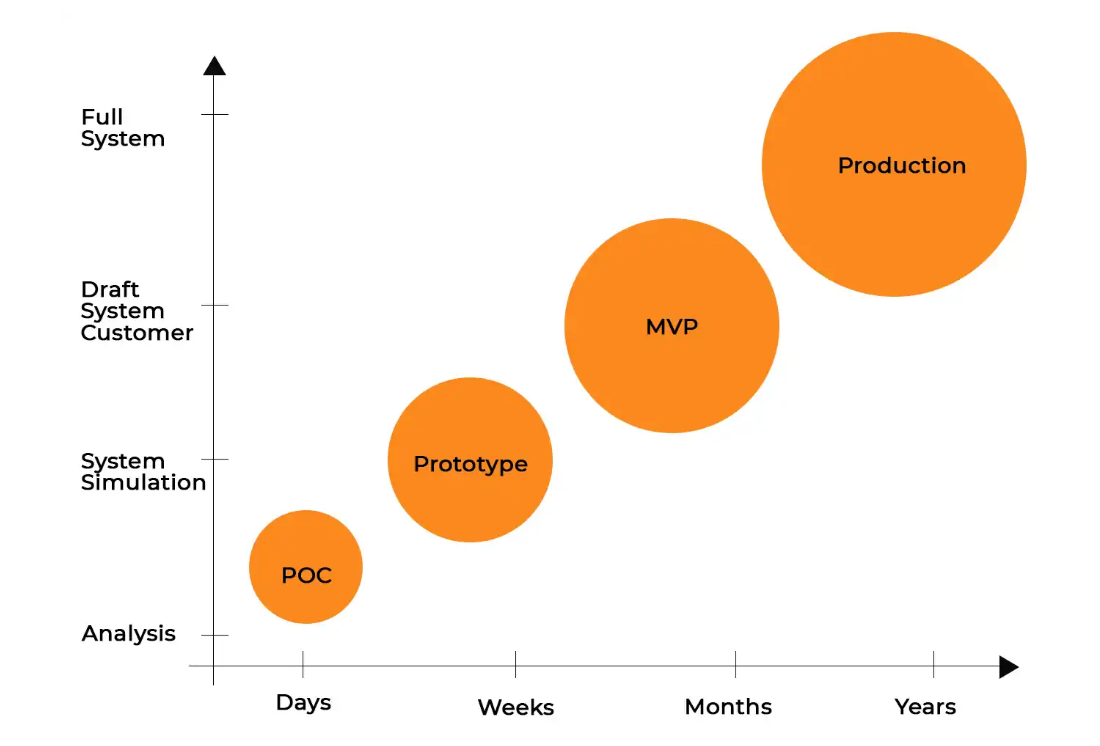
If you are trying to choose between POC vs MVP vs Prototype, consider developing a final product that implements each of these three phases.
Here are the benefits of implementing such approaches:
- Concept Testing: Before product development, you have the opportunity to test the idea and recognize your target audience.
- Faster Development: When you’re developing a product using this approach, you need a minimum set of features. Similarly, it would require more time to deliver a complete product. Thus, your product development will be faster when you upgrade your app development from POC to Prototype to MVP.
- User Loyalty: It allows users to interact with your product at the prototyping stage; you automatically generate enthusiasm and brand awareness.
- Quick Feedback: You may have some expectations on how your product will look and perform, but your ideas may not connect to what the users have. The earlier you get the user feedback, the quicker will be the improvement in the user demand.
- Low-Risk Investment: Investors are more likely to fund your idea if you ensure low investment risk.
Conclusion
Product development is like investigating with a vision in mind. The process starts with placing the foundation right to create a POC and a prototype, supported by an MVP. MVP is a great example of a functional product from all these approaches. But that doesn’t mean the other two methods don’t influence full-stack development.
In the explanation above, I tried to erase the thin line between poc vs mvp vs prototype to validate a successful startup product. Now, if you’re planning to develop a product using these approaches, hand your project to safe hands by searching for the best MVP development company. Make sure that it offers a dedicated MVP software development team and aims to nail down the viability and feasibility of your million-dollar product idea into a successful startup.
Frequently Asked Questions (FAQs)
Why would you launch an MVP and not a prototype?
An MVP is a minimum version of the final product, and it’s delivered to the market right away. This means that it has to be simple and well-polished, without bugs or other problems. On the other hand, prototypes are created for the sake of finding those errors and often are far from being perfect
What technique can be used for planning MVP for a product?
Prioritization Matrix
This step helps you identify where you can make the most impact on the urgency of the feature. Using a prioritization matrix, you can decide what needs to be included in your MVP and what features can be included in later releases.
What comes first, pilot or MVP?
Prototypes will have been followed to shape how the final product will work. Once you’ve refined these prototype designs to a point you’re happy with, the next stage will be a pilot. This is a stepping stone to your full launch of a minimum viable product (MVP) or service.
What is the difference between prototype and testing?
A Prototype can be a test case for an idea. It is achieved not by building a small-scale version of a service or product but by testing several parts to unveil the various possibilities of scaling it to reach the final service or product.